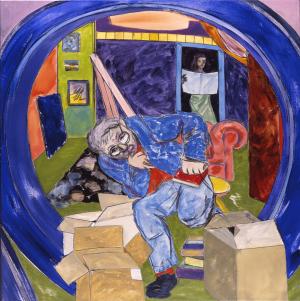The  first large-scale retrospective of R.B Kitaj‘s work in fourteen years is currently on at the Jewish Museum Berlin.
first large-scale retrospective of R.B Kitaj‘s work in fourteen years is currently on at the Jewish Museum Berlin.
R.B Kitaj (1932 – 2007), an American Jewish artist, spent almost 30 years in England. Like his friends David Hockney and Lucien Freud, he turned to figurative art in the 1960s.
His work is highly referential and collagic, drawing on a wide range of literary and artistic sources. He frequently uses newspaper cuttings and other texts in his work. Literature played a significant role in his life – he was a “self-professed bibliomaniac” and part of his huge collection of books are on display in the exhibition. The painting above is entitled ‘Unpacking My Library’, alluding to an essay by Walter Benjamin.
Kitaj’s circle of friends included philosophers, writers, poets and other artists. He drew from their work, and also represented them in his paintings. Below, ‘Two London Painters’, shows close friends Frank Auerbach and Sandra Fischer.

Other friends and role models included Philip Roth, Joseph B. Soloveitchik and Ezra Pound.
Much of his work, such as The Murder of Rosa Luxemburg, La Pasionaria (a.k.a Isidora Dolores Ibárruri Gómez, a leader of the Spanish Civil War) and Dismantling the Red Tent, painted in the aftermath of President John F. Kennedy’s assassination, refers to historical and political events. Another obsession of Kitaj’s was his Jewishness, reflected in works such as ‘Drancy’, which was an internment camp from where Jews were deported to death camps.
The last retrospective of Kitaj’s work, held at the Tate in 1994, received bad reviews and proved a traumatic experience for the artist. He blamed critics for his wife’s death following the end of the show, and left England soon after, never to return. For him, the ‘Tate Wars’ confirmed his position as an outsider. Several works made after this episode reflect his feelings – the most obvious being ‘The Killer-Critic Assassinated by His Widower, Even’ painted in 1997.
In 2007, Kitaj committed suicide. A couple of years ago, The Guardian blog asked, Did Art Critics Kill Kitaj? Whatever the case, the current exhibition proves he was unfairly judged. For more about the artist, read his obituary in The Guardian.
Obsessions is on at the Jewish Museum Berlin, Lindenstraße 9-14, 10969 Berlin, until 27th January 2013.
Filed under: art, Berlin, Life in Berlin
